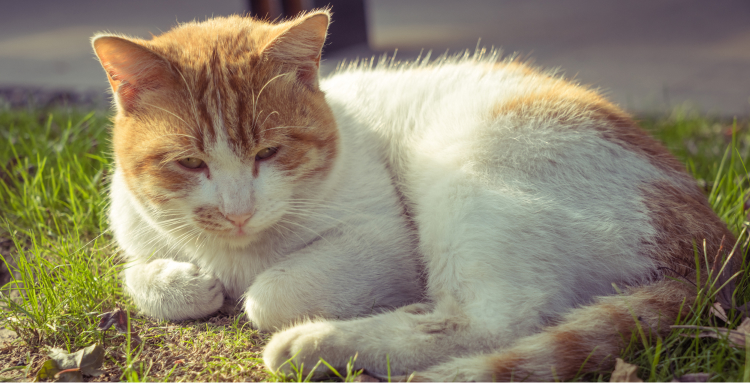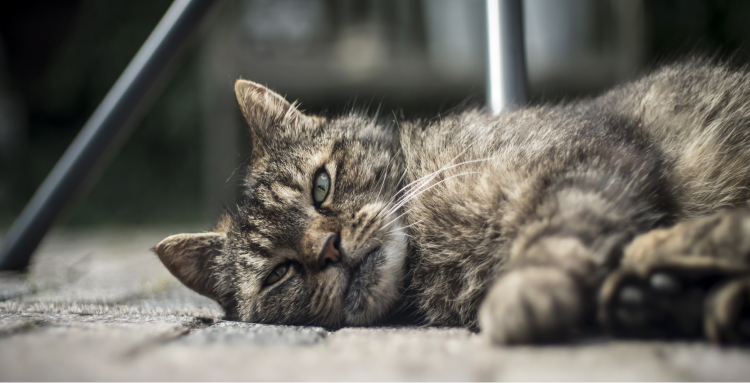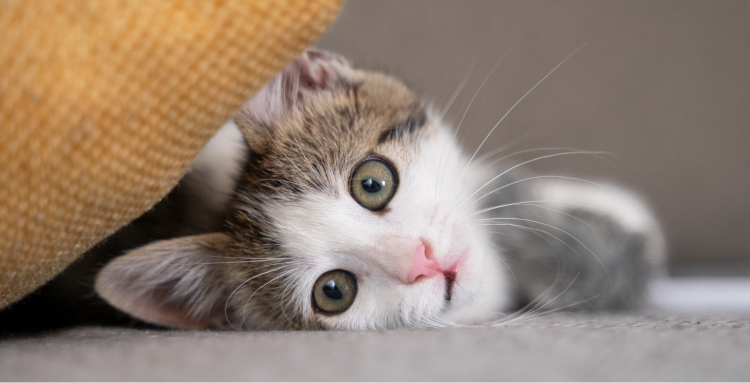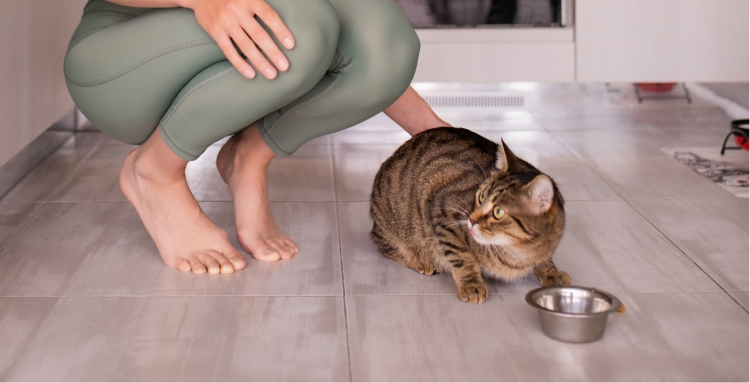Losing weight isn’t just a human struggle – our feline friends can face it too! Even if we look at the statistics of cat obesity worldwide then, In 2020, approximately 59% of cats worldwide were classified as overweight or obese. In the U.S., around 33% of cats were reported to be obese, and nearly 26% were considered overweight. According to International Cat Care, 39% to 52% of U.K. cats are overweight. So, if your cat is one of them, then fear not! With the right approach and some expert guidance, helping your cat shed those extra pounds is absolutely achievable.

When to Consider My Cat is Overweight
Wondering if your cat might be carrying a little extra weight? It’s a common concern, just like us humans keep an eye on our waistlines. So, when should you start thinking, “Hmm, maybe Fluffy needs a bit of a diet”? Well, when your cat is overweight by 15 to 20 percent of an ideal body weight. There are some other ways you can find out.
The first thing you can do is check the cat’s Body Condition Score (BCS). When you run your hands along your cat’s sides, can you easily feel their ribs without pressing too hard? If it feels like you’re navigating through a fluffy marshmallow instead of feeling those bones, your cat might be packing a few extra pounds.
The second thing is visual cues. When you look at them from above, can you see a distinct waistline? Or does it look more like they’re shaped like a sausage? A healthy cat should have a noticeable indentation at the waist, just like a little hourglass figure.
And let’s talk about the view from the side. Is your cat’s belly hanging low, almost touching the ground? That could be a sign of excess weight. A healthy cat should have a tummy that’s tucked up nicely, not drooping down like a deflated balloon.
Beside their physical changes, look for their energy level and grooming. Is your cat as active as they used to be, seem interested in keeping their fur clean or do they spend most of their time lounging around like a kitty couch potato?
Just like us, carrying extra weight can make it harder for cats to move around comfortably, so if your once-sprightly kitty has turned into a nap enthusiast, it might be time to consider their weight.

What Health Risks are Associated with Obesity
Those extra pounds might look adorable on your cat in a “pudgy-pie” kind of way, but trust us, they’re no laughing matter. Obesity is a serious health concern for felines, putting them at risk for a whole host of nasty conditions.
- Diabetes (Type 2):
- Overweight cats are at higher risk of developing diabetes.
- Excess body fat affects insulin sensitivity, leading to elevated blood sugar levels.
- Diabetes management becomes more challenging in obese cats.
- Joint Problems:
- Extra weight puts stress on joints, especially in the hips and knees.
- Arthritis and joint pain are common in overweight cats.
- Mobility decreases, affecting their quality of life.
- Heart Disease:
- Obesity increases the risk of heart issues.
- Fat deposits around the heart strain the cardiovascular system.
- Hypertension (high blood pressure) is more prevalent in obese cats.
- Respiratory Issues:
- Fat accumulation in the chest restricts lung expansion.
- Breathing difficulties and decreased exercise tolerance occur.
- Liver Disease (Hepatic Lipidosis):
- Rapid weight loss or starvation can lead to hepatic lipidosis (fatty liver disease).
- Obese cats are at risk during weight loss programs.
- The liver accumulates excessive fat, impairing its function.
- Skin and Coat Problems:
- Overweight cats may struggle with grooming.
- Mats, dirty fur, and skin infections can result from limited self-grooming.
- Decreased Lifespan:
- Obesity reduces a cat’s lifespan.
- Associated health conditions can lead to premature aging.

How to Help Your Cat Loss Some Extra Weight: In 9 Ways
Alright, it’s official: your cat’s got some extra chonk going on. Don’t worry, it happens to the best of us (well, maybe not literally us)! The good news is, with a little effort, you can help your feline friend shed those extra pounds and get back to their healthy, playful self. Here are 9 purrfect tips to get you started:
1. Consult Your Veterinarian
First things first, schedule a visit with your vet. They can give your cat a thorough check-up and help you come up with a safe and effective weight loss plan.
2. Determine the Target Weight
Work with your vet to figure out what your cat’s ideal weight should be. This will give you a clear goal to aim for as you help your kitty slim down.
3. Adjust Your Cat’s Diet
Say goodbye to the high-carb, filler-packed cat food! Instead, opt for high-quality, grain-free options with lean meats. Spread out their meals throughout the day, focus on high-protein, high-fiber, and low-fat foods. Adding water to their meals can also help them feel fuller for longer. Sodium-free green beans can be a great addition to bulk up their meals without adding extra calories.
4. Monitor Treat Intake
Treats are great for training and bonding, but they can also pack on the pounds. Keep a close eye on how many treats your cat is getting each day and consider swapping out high-calorie options for healthier alternatives. For example, opt for healthy alternatives like freeze-dried meat or small pieces of cooked chicken, and remember, a little goes a long way!
5. Regular Weigh-Ins
Keep track of your cat’s progress by weighing them regularly. This will help you and your vet see how they’re doing and make any necessary adjustments to their weight loss plan.
6. Increase Physical Activity
Just like us, cats need regular exercise to stay healthy. Engage your cat in playtime with feather wands, laser pointers, or interactive toys. Aim for at least 15 to 30 minutes of playtime each day and consider taking your cat for a walk if they’re up for it.
7. Slow-feeders and Food Puzzles
Fast eating can lead to overeating. Slow-feeders and food puzzles can make mealtime more challenging and engaging for your cat, helping them eat more slowly and feel fuller with less food.
8. Stop Sharing Meals
If you have multiple cats, it’s important to make sure they’re not sharing meals. This can lead to one cat eating more than their fair share and gaining weight as a result.
9. Monitor for Medical Issues
Keep an eye out for any signs of medical issues that could be contributing to your cat’s weight gain, such as thyroid problems or diabetes. If you notice anything unusual, don’t hesitate to contact your vet.

Tips to Encourage Your Overweight Cat to Exercise
Cats naturally aren’t big on exercise. In the wild, they conserve energy until it’s time to hunt, then they go all out for a short burst of action. But in our homes, they can become lazy if we’re not careful. So, how do we get them moving?
Here are some simple ideas:
- Change up where you put their food. Move their bowl to different spots around the house to make them explore.
- Keep the food away from their favorite nap spots. This encourages them to move around more.
- Get them interactive toys that make them work for their food, like puzzles or mats.
- Turn mealtime into a game by tossing their food across the room for them to chase.
- Schedule regular playtime with toys like feathers or laser pointers. Just ten minutes twice a day can make a big difference.
Remember, every cat is different, so you might need to try a few things to see what works best for yours. And don’t forget to give them a treat as a reward for their efforts!
Tips to Discourage Your Obese Cat From Wanting to Eat More
Resisting those pleading eyes can be tough, especially when they catch you off guard in the dead of night or right before your alarm clock goes off. But remember, giving in to begging only reinforces the behavior. So, how can you manage those relentless pleas for food? Here are some handy tips:
- Automate Feeding: Invest in an automatic feeder. This shifts the focus from you to the feeder, so your cat learns to associate mealtime with the machine, not your attention.
- Control Portions: Opt for an automatic feeder that lets you control how much food is dispensed at each meal. Alternatively, consider a smart device that tracks your cat’s food intake.
- Attention Over Food: Sometimes, what seems like begging for food might actually be a cry for attention. Instead of offering treats, lavish your cat with love through pets, grooming, or playtime.
- Meal Management: Experiment with meal size and frequency. Some cats may feel fuller with smaller, more frequent meals, while others prefer fewer, larger meals. Find what works best for your cat’s appetite and your daily routine.
- Hydration Station: If your cat’s fixated on the empty food bowl, offer them fresh water instead. A cool drink can help satisfy their cravings without adding extra calories.
By implementing these strategies consistently, you can help curb your cat’s begging behavior and maintain a healthy feeding routine for both of you.
Frequently Asked Questions
How long can it take for a cat to lose weight?
Cats can safely shed around 1.5% of their body weight weekly until reaching their target. Check their weight every 2-4 weeks during the diet period, either at the hospital or by appointment.
How often should I bring my cat in for a follow-up or weigh-in?
After initiating a weight loss plan for your cat with your vet’s guidance, reassessments are crucial to monitor progress. Within one week, even during food transition, check-in. Once fully transitioned, reassess within 1-2 weeks to adjust feeding amounts. Then, weigh your cat at least every other week until reaching the goal weight. Your vet may permit at-home weighing, but monthly clinic visits ensure accuracy.
What’s the expected duration for my cat’s diet plan?
It varies based on individual needs and adjustments. Rapid weight loss isn’t ideal; aim for 1-2% of initial body weight per week, slower for obese cats. Factors include diet acceptance, rate of loss, and total weight to shed. A collaborative effort between you and your vet is key to success.
Can indoor cats lose weight without outdoor exercise?
Absolutely! Indoor cats can engage in various indoor activities and exercises to help them lose weight, such as interactive play sessions, climbing structures, and puzzle toys.
What are some signs that my cat is losing weight too quickly?
Rapid weight loss in cats can be concerning and may indicate underlying health issues. Signs to watch out for include lethargy, loss of appetite, and dehydration. If you notice any of these symptoms, consult with your veterinarian immediately.
Final Words
Helping your cat achieve and maintain a healthy weight requires dedication, patience, and an appropriate approach. By implementing the expert strategies and tips outlined in this guide, you can support your cat’s weight loss journey and enhance their overall quality of life. Remember to prioritize gradual progress, seek veterinary guidance when needed, and celebrate every milestone along the way.

